Matador Network's Blog, page 2138
February 24, 2015
Paddling across the US
NATIONAL Geographic Adventurers of the Year, Dave and Amy Freeman canoed 2,000 miles from Minnesota to Washington DC to bring awareness to dangerous mining projects jeopardizing the Boundary Waters on the Canadian – US border.
Interview with filmmaker Nate Ptacek.
How did you get started working on a project about the Boundary Waters?
I began working with local groups and eventually got in touch with Dave and Amy Freeman – local guides and National Geographic Adventurers of the Year. Working with the group Save the Boundary Waters, Dave and Amy wanted to bring awareness to the issue on a national scale by canoeing 2,000 miles from Minnesota to Washington DC as a floating petition – the canoe was covered in signatures asking our federal government to halt these dangerous mining projects.
Had you experienced the Boundary Waters before shooting the video?
This was a huge passion project for me – during college I spent summers working as a canoe outfitter in the Boundary Waters Canoe Area, an amazing million-acre wilderness on the edge of the Minnesota-Canadian border. It’s my favorite place on earth, and although I now live in California, I still return every September to go canoeing and reconnect with friends. It was on one of these trips back to Minnesota that I first heard about the sulfide mines being proposed: one of the world’s most dangerous and polluting industries, right on the edge of the most popular wilderness area in the nation. I knew immediately that I had to get involved.
How many miles did you travel with Dave and Amy?
My employer, Patagonia, supports employee environmental activism, and allowed paid time off for me to travel and film for the first leg of the expedition – paddling 160 miles through the BWCA, and sailing on Lake Superior.
Overall it was an incredible experience – Amy and Dave are very inspiring and hard-working people, and it was so great to get to know them over the course of the trip. I was even able to join them in Washington for their arrival 100 days later, where we met with elected officials and various government organizations to share our story. The petition canoe – now completely covered in signatures – was officially accepted by Chief Tom Tidwell of the USFS, and was put on display in the Forest Service headquarters in Washington.
What’s next?
Although the Paddle to DC journey is now complete, our work is not yet finished – we are still working toward protecting the BWCA through a buffer zone banning this type of mining within the BWCA watershed. For more information, and to sign the digital petition, go to savetheboundarywaters.org. 
Lead image: Blue~Canoe
12 beautiful images of Palawan
THE Province of Palawan is the largest in the Philippines and home to Palawan Island, previously named by National Geographic Traveler as “the best island destination in East and Southeast Asia.” There are near 1800 islands and islets in the province, stretching white sandy beaches along approximately 1,200 miles of coastline. A large variety of wildlife and mountainous jungles are found on Palawan Island. 
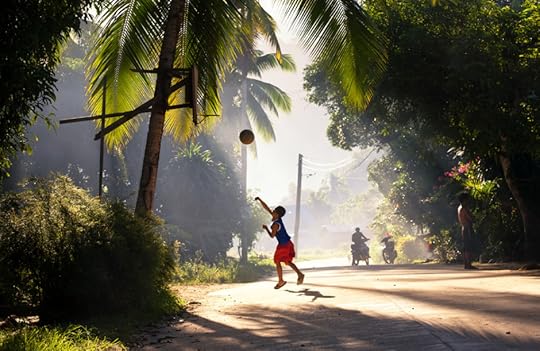
1
Basketball
Basketball was introduced to the Philippines during the American colonial period (1898-1946) and Filipinos are crazy about it. They have a professional league -- the Philippines Basketball Association (PBA), the first in Asia and second longest running pro league in the world behind the NBA.

2
Just one of many white sand beaches
There are many gorgeous stretches of sand near San Vicente; Long Beach is 14km of a so-far undeveloped stretch, one of the most beautiful in the Philippines. Go and enjoy the solitude while there is still time. A new airstrip has already led to the development of large resorts, and it won’t be long before package tours start rolling in.
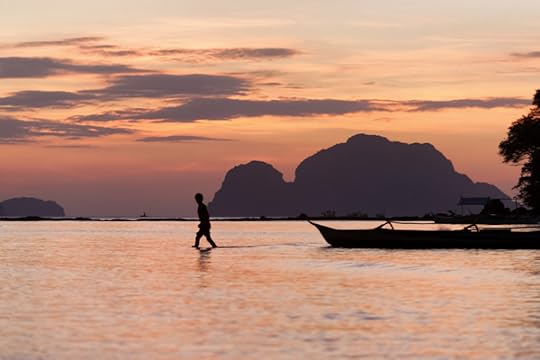
3
Corong Corong beach at dusk
Corong Corong beach is the best place to stay if you want to escape the hectic action of El Nido Town. It’s also a great location to view Palawan's epic sunsets.
More like this: Palawan from the air [vid]

4
Sabang River
Cruising along the Sabang River you can explore centuries-old mangroves in a forest that is free from industrial activities. The mangroves are integral in supporting a rich and diverse marine life.
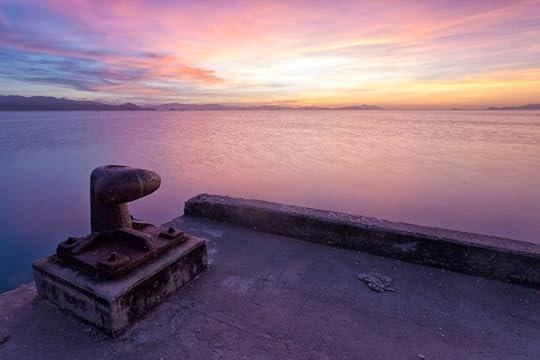
5
Sunset from San Vicente pier
San Vicente's popularity as a tourist destination is increasing as improvements to infrastructure are made. There will always be brilliant sunsets like this though.
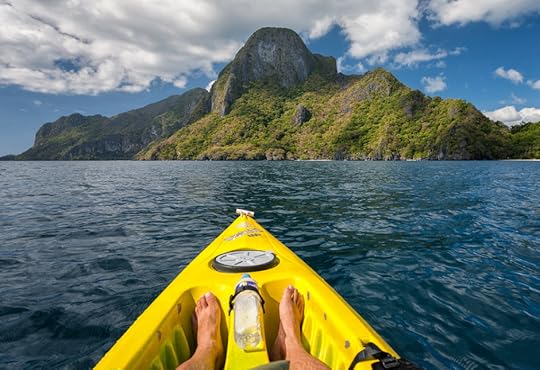
6
Explore by kayak
There are variety of ways you can explore the many islands and islets around El Nido. Organized island hopping and diving tours head out in the early mornings from town. Kayaking around can also be very rewarding and many secret beaches can be found with spectacular snorkeling. Steep limestone cliffs plummet into these crystal clear waters and these Karst formations produce a similar, but even more spectacular scene than the popular Halong Bay in Vietnam or Krabi in Thailand.
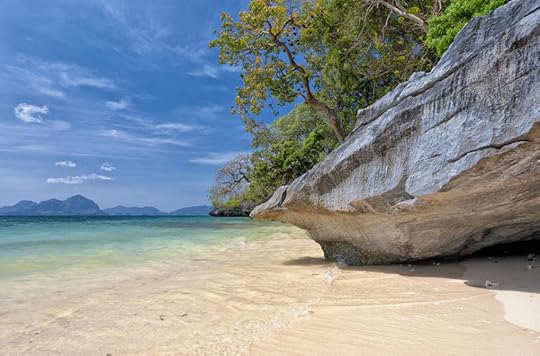
7
El Nido
Almost 150 miles to the northeast of Puerto Princesa — Palawan's capital — is El Nido, named by CNNGo as the "best beach and island destination in the Philippines."

8
Seafood in Sabang
The small village of Sabang is typically used by visitors as an access point to the Puerto Princesa Subterranean River National Park. It's also a great place to buy some fish from the locals and let them prepare it for you in their home.
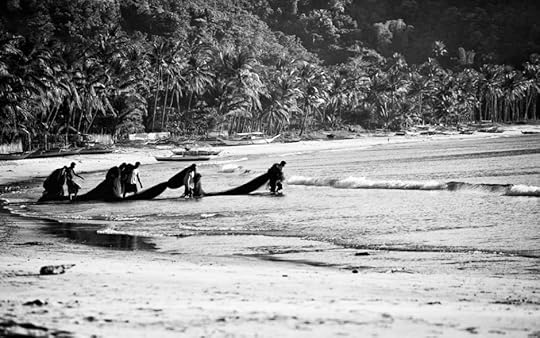
9
Fishermen on Alimanguan Beach
Sleepy fishing villages like Alimanguan near San Vicente still remains hidden to travelers.
Intermission
137
The 22 craziest party hostels around the world
by Matt Kepnes
24
Earth Day in paradise: Palawan, Philippines
by Kate Siobhan Mulligan
1
How to piss off someone from Alabama
by Elizabeth Hudson

10
Port Barton
Between Palawan's capital of Puerto Princesa and the uber-popular El Nido, you can find some remoteness and relaxation in Port Barton. The peaceful nature of this seaside village mostly attracts shoestring backpackers and is not as popular as other areas due to the rough and unpaved road that doesn’t make it quite as accessible to luxury seeking vacationers. There are many islands to explore nearby for diving and snorkelling.
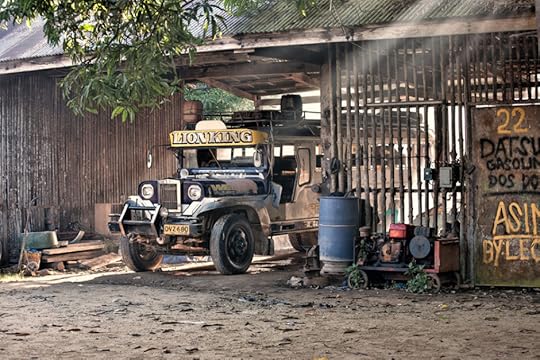
11
Jeepney
The most authentic way to move around on Palawan is to hop on a Jeepney with the locals. These vibrant vehicles with their kitsch decorations are modifications of the US Army Jeeps that were left behind after World War II.
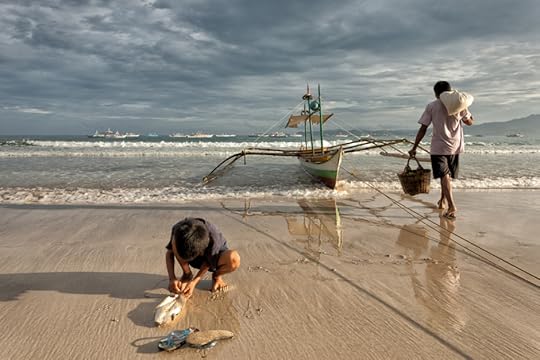
12
Fishing as a way of life
Aside from farming and hunting, fishing has historically been one of Palawan's main economic activities. Around 45% of Manila's fish supply comes from this area.
Signs you need to leave Santiago

Photo by Made in Plute
1. You lose your breath walking to your local panaderia (located a block away).
While Northeasterners in the US have occasional snow days, Santiaguinos have excessive pollution days. Smog levels in the Chilean capital are easily five times what the World Health Organization deems a safe maximum threshold, compelling health authorities to create “smog alerts” for high pollution days. Running outdoors becomes especially challenging as you find yourself gasping for breath within 30 seconds and wondering if you are, in fact, causing yourself more harm than good with your physical activity. The fact that during winter, smog ominously hangs over the city much like dark clouds hover over Mount Doom is also a bit disconcerting.
2. You just can’t deal with calefonts anymore.
Here’s a scenario you may experience one too many times: mid-shower, you let out an ear-splitting shriek because your calefont – heating appliance – has just run out of gas. Not wanting to exacerbate the cold you’ve had for a month already (see #1), you hobble out of the bathroom, blindly groping your way down the hall while shampoo drips into your eyes, and unhook the kitchen’s calefont from the stove. You then lurch your way back to the bathroom, heaving the gas appliance as you go, and hook it to the shower, doing your best to ignore the faint smell of gas escaping the barrel while you make the switch. You hop back into the tub and continue showering, hoping everything’s properly connected and that an accidental gas leak won’t cause you to die an atrocious flaming, naked death.

More like this: 12 side effects of living in Chile
3. Other Latinos don’t understand a word you say because of your new Chilean accent.
You’ve finally wrapped your head around Chilean Spanish — dropping every word’s final syllable as well as a few in between, just for safe measure — only to realize you can no longer communicate with anyone outside of Chile. Your conversation partners respond to you with bewildered stares or encouraging nods, very much like adults condescending to a jabbering toddler before shoving a pacifier into his mouth. To add insult to injury, you find that you still don’t understand 40 percent of what Chileans say, either.

This story was produced through the travel journalism programs at MatadorU. Learn More
4. You haven’t read a book in three months because they cost an arm and a leg.
For a variety of reasons — including an outrageous 19% value added tax and a dependence on foreign imports rather than Chilean publications — books in Chile are frighteningly expensive. Saunter into any bookstore and you’ll quickly feel your morale wane as you see prices as high as US$80.00 for a new hardcover. Unable to read a decent novel for half a year, you’ll have watched so many Community re-runs to the point you’re be able to parrot entire segments in each character’s respective voice. Your roommates will want to kill you, and so will you.
5. You think all men are lurid catcallers.
Expecting most male passersby to whisper some sort of lascivious comment as you walk by them on the street, you viciously snap at one about to open his mouth only to realize he simply meant to alert you to the fact your bag was open. You also occasionally find yourself preemptively whistling at men just to beat them at their own game, in complete defiance of all feminist / humanist principles you ordinarily embrace.
6. The price of palta has gone up.
Avocado, your staple and godsend, costs 100 pesos more. It’s time to go. 
11 signs you drink in Cape Town
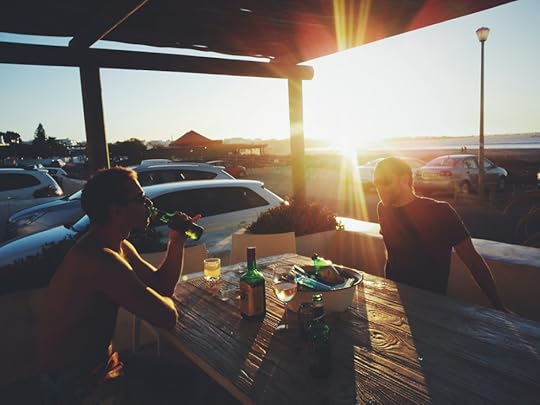
Photo by mallix
1. You use the term “sundowner” for after-work drinks and know that having one is more about the view than the beverage.
2. You can name five sundowner spots in Cape Town in under 30 seconds. And you always select the best fit for the day based on the chance of rain, tide, and wind direction.
3. You know how to inflate an empty “papsak” and use it as a satisfactory substitute for a pillow. (That’s the foiled bag container from a box wine, by the way.)
4. You know all the ways to conceal a drink on a Blue Flag beach or smuggle some into the Table Mountain National Park. And you would absolutely never leave any trace that you were doing so.
5. You don’t drink and drive. In the CBD, you either walk or Uber. And for wine tours, it’s obviously a rented, off-duty, minibus taxi with a group of friends.
6. Before drinking any wine, you swirl-sniff-sip — whether it’s a bottle of Tassenberg (famous local ‘plonk’) or a Cederberg Shiraz (famous local not-‘plonk’).
7. You know the difference between a Pinot Noir, Hermitage, and Pinotage and you take pride in informing others — whether they are interested to know or not.
8. On Saturday afternoons, an internal wine / beer / whiskey o’clock reminds you to buy liquor before the stores close.
9. In the unfortunate event that you can’t meet the store-closing deadline, you know that:
A. Harvey’s Liquor on Wales Street will be open after hours.
B. You may have to round the block five times before finding parking.
C. Their prices are highly inflated and some customers will be wasted, which begs the question: Will this single malt be worth the price tag and risk of someone being sick on and/or grinding up against me in the queue?
And D. The only alternative is trying to exit the local corner shop inconspicuously following a slightly illegal, but comparatively painless exchange for a brown-paper-bagged bottle of wine.
10. At least one of your local friends is a professional beer brewer or winemaker.
11. But you also know people who have made their own wine, beer, or cider in their bathroom, garage, or tool shed. And you’re planning to do the same. 
5 edible Latin American bugs
IF you’re hungry enough, then you’ll eat it. That seems to be the reasoning from the United Nations as it promotes “entomophagy,” the fancy scientific name for eating insects, as the key to food security in the 21st century.
With increasing ecological depletion and the earth’s human population set to reach as much as 11 billion by 2040 — compared to today’s 7 billion — bugs are one of the cheapest, most efficient and nutritious food sources available.
Yuck, you might say. But in many parts of the world, including Latin America, they’ve been eating tasty, tiny creatures with way too many legs since time immemorial.
Here are five highlights:
Wriggling weevil babies

Weevil larvae in Peru. (Daniel Rosenberg/YouTube)
No, not the daughter of Tom Cruise and Katie Holmes. In Peru, suri is the name of the outsize larvae of the palm weevil, a staple of the Amazonian diet. An inch or two long, fat and fatty, this grub can be fried, roasted, or barbecued on a spit. Locals in jungle towns, however, prefer to offer it to visitors not just raw but live and wriggling.
Grasshoppers and beer
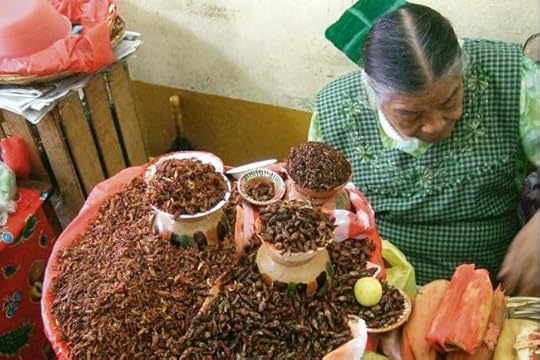
Chapulines at a market in Oaxaca. (Beelzebubilein/Wikimedia Commons)
Mexicans have been eating all kinds of arthropods since long before the Spanish showed up in the 16th century. Chapulines, or grasshoppers, are probably the most famous. There are various recipes but a personal favorite is Oaxacan-style; deep fried and smothered in chili powder. Spicy and salty, they go perfectly with a cold cerveza.
Ant larvae tacos
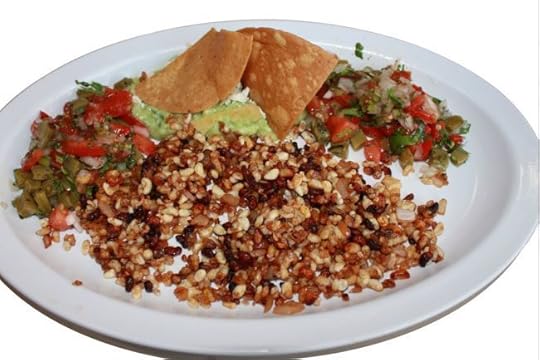
Ant larvae for dinner. (Cvmontuy/Wikimedia Commons)
Another Mexican classic is escamoles, ant larvae that are a common delicacy in the Yucatan peninsula. They are harvested from agave cactuses used to make tequila and mezcal. Often described as “nutty” and “buttery” in flavor, they are typically served in a tortilla, along with the usual Mexican musts of hot salsa, salt and lime juice.
Barbecued tarantulas

Goliath bird-eater tarantula. (John/Flickr Commons)
OK, OK, so spiders aren’t insects. But this one was too good to leave out. Various cultures around the world eat tarantulas but the Piura tribe in the Venezuelan Amazon have the best recipe. They barbecue goliath, aka “bird-eating” tarantulas whole, on the end of a stick. Cooked this way, the giant spider, the size of an adult human’s hand, is about as crunchy as Col. Sander’s extra crispy chicken recipe.
Big-assed ants

Colombian fried ants. (Sascha Grabow/Wikimedia commons)
In Colombia, they like their ants culonas or “big-assed.” They even export them to Europe now, where one company sells them covered in chocolate. In Brazil, the preference is for queen ants, or ica, of several species. Amazonian ants aren’t like their US cousins; they can get up to an inch long and many are poisonous. They can be cooked in various ways or eaten raw. If you do eat them alive though, be sure to rip off their lower jaw to stop them biting inside your mouth!
By: Simeon Tegel, GlobalPost
This article is syndicated from GlobalPost.
February 23, 2015
How to deal with travel envy

Photo: -MRGT-
1. Take a break from the travel blogs.
Ugh. Admit it: you only look at most of them for the pretty pictures, anyway. Most of the content is trite, lacking, ridden with self-aggrandizing language, and the more-than-occasional typo. They’re the Facebook of the travel industry and sometimes you just need to take a break for a while. If you’re really addicted, switch to plain ol’ international news outlets, literary travel writing, and commercial websites. They’re less personal and more educational — and therefore more likely to fuel the fires of motivation instead of the fires of jealousy.
2. Start planning a trip now.
It doesn’t matter if it’s never going to happen; just do it. Go on airfarewatchdog.com and find the cheapest routes out of your preferred airport. Once you find a couple of destinations you wouldn’t mind going to, research them. Find reviews on non-shitty hostels or respectable but out-of-the-way boutique hotels, what hot spots you want to be seen drinking mojitos in, what tattooed characters you want to make out with in which sleazy dive bars, and what photos you just have to take for your blog because if you didn’t, you’d hate yourself. Get it down to an art. Maybe you’ll go, maybe you won’t. But you’ll probably go.
3. Create your travel budget.
This is not a trip budget: this is a travel budget — there’s a difference. One is allotting how much money to spend on what things, and the other is how much money you can cut down. You’ve been spending your money to live, not spending your money to travel. Now that you know there’s someplace beckoning you in your immediate future — or many, many places — it’s time to listen to that and start saving up. You may not spend this money for six months, you may not spend this money for two years — but it’ll be there when you finally need it. Where does it come from? That skipped latte, the move to just Netflix, the weekend-home-cooking vow. It’s not how much money you need, it’s how much money you can save.
4. Start an at-home “around the world” tour.
Sometimes when you’re stuck at home, slaving away at your 9 to 5 saving up, or simply just waiting for the rainy season to pass, you’ve gotta bring the world to you. Document all the interesting types of cuisine in your area — is there an Ethiopian place you’ve yet to try? Maybe Burmese? If you live somewhere with a little less ethnic flavor, consider that an occasion for a dinner party. In this scenario, the internet is your best friend.
But it doesn’t stop at just food. Check out that Czech museum 45 minutes away. Go see that Lithuanian Polka band that you would otherwise never go to. Just because you’re “at home” doesn’t mean you have to do “at-home” things. Your world can be whatever you want it to be if you’re willing to create it.
5. Fill your schedule with “somethings” instead of “somewheres.”
Traveling isn’t just about going — it’s about doing, too. If you simply went to Istanbul and didn’t do anything, that wouldn’t be much of a trip, right? Life isn’t about where you are, but what you’re doing with it. “Exotic” and “adventurous” are subjective, and you have the means to do interesting, write-home worthy things without booking a $1500 plane ticket to Timbuktu. The reason home feels like home is because it’s full of daily routines. When you switch up those routines — when you take a Saturday to go zip-lining or a night to stay at a B&B — home no longer feels like monotonous, run-of-the-mill home. Keep busy and your life can feel enriching wherever you are.
6. Start reaching out to all your global acquaintances.
Keeping busy will feel good, but there will always be that itch to go somewhere you don’t recognize, where your senses are on high alert and your adrenaline is flowing freely. As part of this keeping busy, living-globally-at-home lifestyle, start hitting up all your friends around the world just to say “Hi.” Get back into their good graces, since it’s probably been a while since you’ve had a chat. Drop a convivial, un-needy line now and you can drop the actual bomb later: “Hey, can I crash on your couch in a couple of months?”
7. Funnel your creativity into a project.
You have all this zest, this fire, this drive — why not do something with it? Plan a mystery trip for you and a few friends. Paint one of your favorite scenes. Start writing about the places you’ve been. Heck, this could be the green light for what you’re meant to do: selling your baklava to local bakeries, planning local tourism events, or heading up a language club. And who knows? It could be your ticket on the next train out whether it’s through meeting new people, hearing of new opportunities, or just getting you closer to where you want to be. And even if it doesn’t, your schedule will feel worthwhile, productive, and feel like a step in the right direction.
8. Remember your hometown is a destination to someone else.
There are so few places on Earth that have never seen a tourist; odds are if you’re reading this, you’re not in one. There is someone right now who is Googling your town and wondering (and finding!) fun things to do. Put yourself in their shoes: where’s the best cup of coffee? Where’s the closest, most accessible adrenaline rush? The best bike path or vegetarian burrito? And when you find something worthy, take pictures of it. Open your eyes and look around like you’re seeing it for the first time. What’s something you’ve never noticed before? When you channel your inner tourist, when you realize your adventure is just as unique as anyone else’s, you’ll feel a little sated. Your resolve will be that much stronger, and when that monster starts whispering again, you’ll know just where to tell her she can go. 
Tips for dating an Italian girl

Photo: aenimation
1.What getting a phone number means
An American girl giving you her phone number means she is considering going out with you. It doesn’t take long to get — after all, it’s her number, not a wedding ring. The same for Italian girls, right? HA!
With an Italian girl, you will work hard just to get her phone number. Right away, she wants to have an idea of how hard you are going to work to get her attention. In Italian we say (roughly translated): “He who begins well is halfway done”. Begin.
2. Who asks who out
An American girl will show you if she has interest in you, and she won’t be afraid to ask you out.
An Italian girl probably won’t ask you out first. Actually, take the ‘probably’ away. You need to ask her out first, always. Even the second time. And the third time.
3. Game on
An American girl isn’t so much into ‘the chase’ — she generally doesn’t run away for too long, or too far away. If she says she can’t go when you ask her out for a date, it’s probably true. Insisting too much would be inappropriate.
An Italian girl always wants to know how much you are willing to work for her. The fact that she says no the first time doesn’t mean she can’t go out or doesn’t want to. She is testing you. Now, the third time she says no, she means it (and don’t insist). But don’t take the first no as a fail. It’s a challenge, so accept it.
4. Primping required
American girls pay attention to how they dress, but guys… not so much. They’re often deemed as looking acceptable once they meet the minimum standards.
Italian guys take the same amount of time to get ready as American girls. On the one hand, fashion, elegance, and taste are embedded in the Italian culture, so Italian guys don’t even notice they have this going for them. But in Italy, especially for the first date, looks definitely count a lot.
5. Odd numbers mean good odds
An American girl can take time away from her friend to talk to you on a night out. She might even ditch her friend for half the night, depending how interested in you she is.
An Italian girl would never leave her friend alone. Therefore, either have a friend so you all pair up, or you need an odd number: 1, she is by herself; or 3, so she can spend some time with you because she leaves two friends together.
6. Chivalry is definitely not dead
American girls are much less used to guys being gentlemen — opening the door for the lady, waiting for her to sit before you sit, etc. Also, American girls often offer to share the bill after a few dates.
In Italy, it is going to be much longer before a girl pays for something when you go out for a coffee / drink / dinner. Italian girls expect, and demand, chivalry. Rightly so.
7. Skilled flirting is mandatory
American girls like flirting, but they’re much more direct. A good flirt is always enjoyable, but perhaps they are not too used to it.
For Italian girls, it not only is the ‘cherry on top of the cake’ (as we say in Italy), it is an art you are going to have to master if you want to date an Italian girl. 
17 signs you're from Chicago
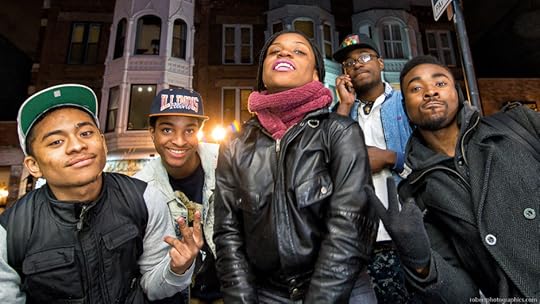
Photo: Robert Martinez
1. You know what “Lake Effect” means.
Bundle up, that’s what.
2. You’ll always think Channel 11 is the best public access channel ever.
You learned to cook with the Frugal Gourmet, listened to the Chicago Symphony Orchestra, and first fell in love with Siskel & Ebert and their movie reviews watching WTTW.
3. You know the Empire Carpet jingle by heart.
Sing it with me: 800-588-2300 EMPIRE!
4. Coach Ditka and The Bears are your religion.
You still listen to the Super Bowl Shuffle and routinely chant, “Daaaaa Bears Da Bears Da Bears Da Bears!”
5. You still rep the reign of Jordan (rightfully so).
You outreach your arm, tongue wagging in the air for pictures, and break out your number 23 jersey to attend Bulls games (or to go anywhere in the city).
6. For you, LSD isn’t just a psychedelic drug.
Lake Shore Drive (LSD for short) is one of the prettiest inner-city drives in the country. Traffic can be a nightmare, but it doesn’t bother you because you have front row seats to the number one thing that makes your city so great: Lake Michigan.
7. You’ve left the house bundled up looking like Randy from A Christmas Story.
After Tom Skilling issued the warning for impending sub-zero temperatures, you’ve left the house wearing a minimum of 3 layers including a snowsuit, mittens, and face mask.
8. You’d never dare put ketchup on your hotdog.
All Chicagoans know that their hotdogs are to only be comprised of the following: An all-beef dog on a poppy seed bun topped with tomato slices, white onions, relish, a pickle spear, sports peppers, celery salt, and mustard. It’s a cardinal sin to even consider reaching for the ketchup. Chances are you tried to once, but a hardcore Chicagoan slapped your hand away from the bottle.
9. Even though Brookfield Zoo is bigger, you know Lincoln Park Zoo is better.
Although Brookfield is more “fancy,” you prefer Lincoln Park Zoo to the hoity-toity suburbanite zoo any day. You appreciate that Lincoln Park Zoo is right near the lake in the city, and best of all, it’s free!
10. The “El” isn’t just a letter in the alphabet.
You’ve never had a problem getting where you need to go in Chicago because you’ve always relied on the El. Every local knows that the “El” stands for Chicago Transit Authority’s elevated rail system, but that’s too much of a mouthful. “I’m gonna take da El down to Chinatown for some of dat der Dim Sum.”
11. You’ve attended The Taste every year.
Nothing stands between the crowd of a million plus people and your love for a barbecued turkey leg. The Taste of Chicago has always been and always will be a staple of your summer festival schedule.
12. You grew up vacationing in Wisconsin Dells.
You remember going up to The Dells before it was the waterpark capital of the world. You probably stayed at Old Newport in a modest little cabin and rented a boat to explore the upper and lower Dells’ rock formation beauty. And you’ve most definitely ridden the Wisconsin Ducks.
13. You still call it Sears Tower.
You absolutely refuse to call Willis Tower by its new name and still refer to it as Sears Tower.
14. You know who the hell Svengoolie is.
You eagerly look forward to Svengoolie and his top hat-makeup-wearing shenanigans on television. His low-budget hosted horror movie program is chock-full of corny jokes, commentary, and trivia. You can’t get enough of his ghoulish getup any time of year, and you just can’t pass up another viewing of The Brides of Dracula.
15. You or someone you know has a cottage in Michigan “on the lake.”
As soon as the weather turns nice, you’re planning a getaway to your cottage for a weekend of grilling out, boating, wave running, and bonfires.
16. You know some of the best food is slung from Mexican pushcarts.
Tacos, tamales, corn, chicharrones, Mexican cokes, frozen chocolate-covered bananas: the treats found from a Mexican pushcart are endless. Usually while relaxing on Oak Street Beach you hear the familiar sound of bells jingling. Like a Pavlovian dog, you immediately begin to salivate, dig for your wallet, and chase down the pushcart for some Mexican treats.
17. You’ve learned to accept that there are two seasons in Chicago: Winter and Construction.
Construction is nearly constant in the spring and summer months. With pothole damage caused from long, hard winters, road construction easily sets back your commute 30 minutes to an hour every day. 
Signs you learned to drink in Ohio
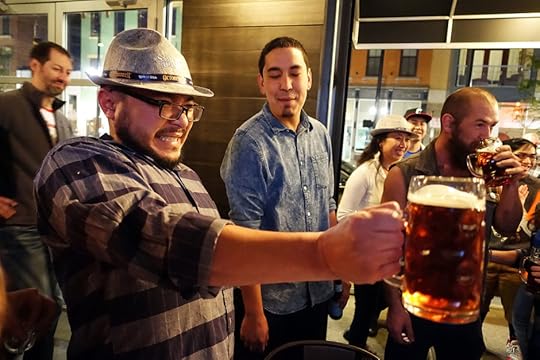
Photo by TemporarySpastic
1. You have at least one friend with party plates.
Sure, everyone tries to secure a DD before heading out for the night, but it’s so easy to start the night by saying, “I’ll just have one,” and then end the night by getting a DUI and earning the scarlet letter license plates.
2. Your first illicit sip of booze was in the basement of a friend’s parent’s house while they were on vacation.
I mean, let’s face it: you’re way more likely to get caught using a fake ID at some shitty bar than you are scattering into the woods when the cops break the party up.
3. You’ve drank way more Natty Light than you care to admit.
If you’re a Cincinnatian, you justified this by saying, “Don’t trash the ‘Nati: Let the Natty trash you.”
4. Your list of favorite drinking venues includes a stadium parking lot and an outdoor music pavilion.
I don’t know if we invented tailgating, but we damn well perfected it.
5. When you left the state the first time, you never understood why convenience stores wouldn’t sell you beer.
Why would you go into a convenience store if not for beer?
6. You’ve spent more on beer in a UDF than you have on ice cream.
The shakes are pretty good, but if I wanted ice cream, I’d go down the road to Dairy Queen.
7. Paying $5 for a beer makes absolutely no sense to you.
Why? Why would anyone in any other state pay that much for a beer?
8. You’re way better at playing cornhole when you’re hammered.
For whatever reasons, 10 beers gives you the perfect amount of lift and rotation on the bag.
9. Someone has unironically suggested cow-tipping while you’ve been drinking.
You probably didn’t do it, but the fact that it was suggested was bad enough.
10. You’ve furtively swigged Jack Daniels out of a Coke bottle underneath the bleachers during a high school football game.
Or some shitty off-brand diluted whiskey like Old Dan Tucker, if JD was too rich for your tastes.
11. Your pregaming was always better than the actual going out.
No offense to Ohio bars and clubs, but there’s something special about drinking on porches, in basements, or in kitchens while talking to friends that pubs and dancing could never really make up for.
12. You’ve had shots with a professional football player.
In both Cincinnati and Cleveland, it’s relatively normal to stumble across a Bengals or Browns player while out for a weekend drink. I do not know anyone in Cincinnati who hasn’t been at a bar with Rey Maualuga.
13. Cabrewing is literally your favorite thing in the world.
A cooler of beer in a canoe or a tube while you float down a lazy, summertime river? Absolutely perfect.
14. You’ve traveled once — just once — to Kentucky for a bottle of Everclear.
It was not worth it.
15. You grew up drinking light beer, but are now submerged in a sea of craft beer.
Ohio has been at the vanguard of the craft beer revolution — which seems unlikely considering how ubiquitous shitty light beer was for so many decades.
10 effects of living in Savannah

Photo: lovehatekara
1. You often forget what century it is.
Savannah is all about historic preservation — nothing too tall, nothing too modern. Antebellum structures are refurnished into restaurants and business establishments. Lanterns light “steamboat gothic” porches. Spanish moss drapes from live oak and caresses the 18th-century cobblestone streets.
And if it weren’t for the high population of skateboarding hipsters holding plastic cups of PBR and sporting nonprescription glasses, it would be easy to get swept away in a time warp to the days of birdcage dresses and salty pirates soaked in rum. Though, don’t get me wrong, there’s still a lot of rum soaking here.
2. You’re hungover more mornings than not.
George Washington once came to Savannah and ordered a Chatham Artillery Punch — a concoction of tea, lemon, brown sugar, wine, rum, brandy, gin, and whiskey. It left him so hungover, he swore never to return.
Not much has changed. We still serve the same punch at the Shrimp Factory.

More like this: 12 things to do in Savannah while you're still in your 20s
3. Your taste buds are forever spoiled from Shit Yeah! Sauce.
We’ve got Zunzi’s where you can order an Oliver’s Lunch from the guy behind the food bar. “Shit yeah!” he’ll say as he slams your plate full of creamy mashed potatoes, Italian-seasoned chicken, and smoked South African sausage, all drenched in Tzatziki dressings with a gravy known only as “Shit Yeah! Sauce.”
Or for a celebrity meal from Zunzi’s, there’s the Conquistador. This hoagie was featured as one of the final contestants on Adam Richman’s Best Sandwich in America on Man vs Food.
We’ve got the Savannah Bee Company where you can taste a free slice of green honey crisp apple topped with a slab of honeycomb and Gruyere Cheese. We’ve got creamy bowls of crab bisque laced with sherry. We’ve got plates of grits whipped with cheese, seasoned shrimp, sauteed sweet red peppers, and slices of andouille sausage moistened in a Cajun butter sauce. We’ve got rose petal ice cream from Leopold’s. We’ve got greasy pizza from Sweet Melissa’s that will sop up the night’s debauchery.
We’ve got all the ingredients needed for one to eat their way through the city. And it can be done all while avoiding Paula Deen’s restaurant — The Lady and Sons. Which brings me to my next point…
4. Paula Deen? Nope, not a fan.
No, you’ve never met her. No, you’ve never seen her. No, you don’t eat at her restaurant. Do you care to? Maybe if you’re ever craving a burned hole in your wallet from mediocre buffet food doused in melted butter served with a side of fried pig lard and an aura of looming racism.
5. You know that trying to find your way around other cities will forever suck.
Savannah was dubbed America’s first planned city. It’s not only one of the most walkable places in the country, it’s also one of the easiest to learn. When you visit, say, Atlanta, nothing throws you for a loop harder than trying to find your way around that spaghetti junction of a place.
Savannah, on the other hand, is laid out in a perfect, flat series of grids fastened together by 22 historic squares. Within two days, you’ll have the streets memorized and the layout down pat. Just remember that, when in doubt find Abercorn Street, and if you fall into the river, you’ve gone too far.
6. You’ve begun to appreciate the smell of sulphur.
Complain about the river’s pungent smell all you want. While away from Savannah, nothing takes you back to River Street faster than getting a whiff of rotten eggs.
7. You’ve become immune to paranormal activity.
There’s only a handful of people here who claim to have never encountered anything supernatural. And they’re obviously lying.
But being the second-most haunted city in America does have its perks. After you survive a late 19th-century house where doorknobs fall off for no reason, a pissed off shadow bangs around in the kitchen, random puddles of water appear out of nowhere, and an apparition cries continuously in your bedroom, it takes more than a little paranormal action to rattle your bones.
Mass graves? Psh, no big deal. Your house is probably on one right now.

This story was produced through the travel journalism programs at MatadorU. Learn More
8. It now slips your mind that drinking in public isn’t cool everywhere.
Savannah is one of only six cities in America where you can drink in public, permitting that you’re not carrying more than 16 ounces and it’s concealed in a plastic cup. You will forever be yelled at for trying to leave with a drink in your hand.
9. You think you’re Irish.
We have the biggest St. Patrick’s Day Parade in the United States. Irish flags hang proudly in the windows. We throw back Jameson shots like it’s our daily vitamin.
Yet in the entirety of calling Savannah your home, you’ve only encountered one person from Ireland. Then, after hearing about his life back in Cork and marveling in his slurred Irish accent, he admitted over a bottle of Bailey’s that he, in fact, had been born and raised in Savannah. Turns out, he didn’t actually have an accent. He was just really Catholic.
Maybe it’s the fact that we dye our fountains green in March, or because the first baby born in Savannah was born on St. Patrick’s Day. Maybe it’s due to the early 19th-century settlers from Ireland who helped build the economy with their long hours for low pay. Or maybe because we have one of the largest Catholic cathedrals in the South.
No matter the reason, when we’re all gathered in a cluster of green attire to celebrate a holiday in which we have little affiliation with, we all feel strangely connected to Irish culture. Then again, it may just be because we’re drunk and wearing a pin that says: “I’m not Irish, but kiss me anyway.”
10. You fucking love this place.
When General Sherman carried out his famous March to the Sea during the American Civil War, he was so taken with the beauty of Savannah that he offered the town to President Lincoln as a Christmas present. This ultimately saved Savannah from being burned to the ground.
And today, she’s just as beautiful as she was back then — just slightly dirtier and a whole lot sultrier. 
Matador Network's Blog
- Matador Network's profile
- 6 followers



